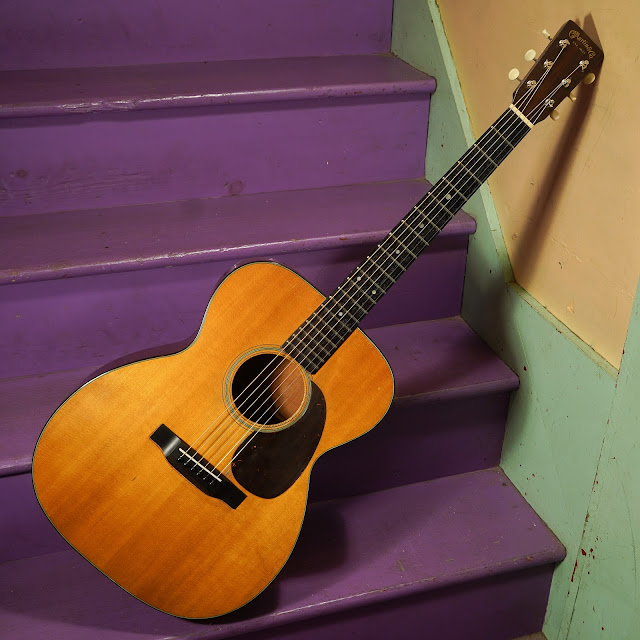1950 Martin 000-18 Flattop Guitar
This old Martin is a stunner. It's got a clean, balanced, even, clear sound to it that makes it an excellent crosspicker and fingerpicker. The owner was asking if I knew the spruce variety in the top and my response is: oh no! Don't get me into that game! I would have to wager that it's probably sitka, however.
It has some mismatched parts (non-original but correct-ish tuners, a replacement bridge, etc) and a little wear hear and there, but overall it's been kept nicely over the years. Post-repairs it plays bang-on, has plenty of saddle for action adjustments into the future, and is ready to serve.
Repairs included: a neck reset, fret level/dress, replacement bridge, replacement (period) tuners, new bone saddle, cleaning, and setup work.
Weight: 3 lbs 12 oz
Scale length: 24 7/8"
Nut width: 1 11/16"
Neck shape: medium C with hair of V
Board radius: 16"
Body width: 15"
Body depth: 4 1/8"
Top wood: solid spruceb
Back & sides wood: solid mahogany
Bracing type: x
Bridge: ebony
Fretboard: Brazilian rosewood (nearly black/ebony in color)
Neck wood: mahogany
Action height at 12th fret: 3/32” bass 1/16” treble (fast, spot-on)
String gauges: 54w-12 lights
Truss rod: non-adjustable
Neck relief: straight
Fret style: medium
Condition notes: this guitar its quite clean save a little finish disturbance behind the bridge and various small scratches and teensy dings/nicks here and there in the body and back of the neck. There's a little weather-check in the finish here and there, too. The tuners are replacements (it originally had large-plate Klusons on it with open backs) and 5 are '50s-era large-plate Klusons from a different guitar and 1 is an earlier, '30s or '40s large-plate Klusons. The buttons match as well as possible. The bracing is all tidy inside, the bridge plate tidy as well, and all is good to go.
A note on the bridge: the bridge is not correct for this period of Martin and when it came in, the bridge it had on it was not correct, quite shaved, and either its position or Martin's original positioning of the bridge was incorrect as the saddle was almost 1/16" aft from where it should be. This should have a rosewood, through-cut-saddle bridge if we're being historic about it. When I was working on this, I thought the owner was keeping both this guitar and another 000 he brought in as players, so I repaired it as a working guitar for him. The rosewood fretboard on this is so dark that it looks like ebony (it's not just oil -- it was the same color on the underside of the board), so rather than use a rosewood bridge, I used an ebony one with a drop-in saddle for functionality and to match the looks better than streaky rosewood. If authenticity is important for the next owner, I can easily recut this bridge to a through-slot saddle style or I can make a fresh, repro bridge from the Madagascar rosewood I have on hand that looks much like Brazilian -- both on the house. I think the current setup as it looks now is superior to both options, but my focus is on functionality, of course.
It comes with: an original, brown chip case -- nothing to write home about.
Consignor tag: DC





















Comments